Numerical Simulation Experimental Study of the Deformation and Failure of Granite with Multiaxial Tension
Abstract
:1. Introduction
2. Model and Numerical Simulation Scheme
2.1. Introduction of CASRock
2.2. Modelling
2.3. Model Parameter Presetting in CASRock
3. Two-Dimensional Experimental Results
3.1. Brazilian Splitting Experiment
3.2. Uniaxial Direct Tension Experiment
4. Two-Direction Tension Experiment Results and Discussion
4.1. Fracture Changing
4.2. Strength Change
4.3. Changing the Elastic Modulus and Poisson’s Ratio
5. Three-Direction Tension Experiment Results and Discussion
5.1. Fracture Changing
5.2. Strength Changing
5.3. Change of the Elastic Modulus and Poisson’s Ratio
6. Conclusions
Author Contributions
Funding
Institutional Review Board Statement
Informed Consent Statement
Data Availability Statement
Acknowledgments
Conflicts of Interest
References
- Asem, P.; Wang, X.; Hu, C.; Labuz, J.F. On tensile fracture of a brittle rock. Int. J. Rock Mech. Min. Sci. 2021, 144, 104823. [Google Scholar] [CrossRef]
- Pan, Y.; Luo, H.; Tang, Z.; Li, Z.; Zhao, Y. Study on charge induction rule of tensile instability failure of coal and rock mass. Rock Mech. Eng. Rep. 2013, 32, 1297–1303. [Google Scholar]
- Liang, H.; Guo, P.; Sun, D.; Ye, J.; Zou, B.; Yuan, Y. Research on stress wave propagation and crack propagation rule of different cohesive blasting modes. Vib. Impact 2020, 39, 157–164. [Google Scholar] [CrossRef]
- Guo, F.; Liang, Z.; Gong, B.; Li, G. Tensile failure in slope stability analysis of geotechnical engineering. Rock Mech. Eng. 2017, 36, 3192–3205. [Google Scholar] [CrossRef]
- Liao, Z.; Zhu, J.; Tang, C. Numerical investigation of rock tensile strength determined by direct tension, Brazilian and three-point bending tests. Int. J. Rock Mech. Min. Sci. 2019, 115, 21–32. [Google Scholar] [CrossRef]
- Carmona, S.; Aguado, A. New model for the indirect determination of the tensile stress–strain curve of concrete by means of the Brazilian test. Mater. Struct. 2012, 45, 1473–1485. [Google Scholar] [CrossRef]
- You, M.; Su, C. Theory and experiment of plate splitting. J. Rock Mech. Eng. 2004, 1, 170–174. [Google Scholar]
- Su, B.; Wang, Q. Experimental study on dynamic tensile properties of Brazilian disc specimens. Constr. Build. Mater. 2004, 1, 22–25. [Google Scholar]
- Kliot, K.; Charney, I. The geography of suicide terrorism in Israel. GeoJournal 2006, 66, 353–373. [Google Scholar] [CrossRef]
- Sha, S.; Rong, G.; Peng, J.; Li, B.; Wu, Z. Effect of Open-Fire-Induced Damage on Brazilian Tensile Strength and Microstructure of Granite. Rock Mech. Rock Eng. 2019, 52, 4189–4202. [Google Scholar] [CrossRef]
- Li, L.R.; Deng, J.H.; Zheng, L.; Liu, J.F. Dominant Frequency Characteristics of Acoustic Emissions in White Marble During Direct Tensile Tests. Rock Mech. Rock Eng. 2017, 50, 1337–1346. [Google Scholar] [CrossRef]
- Wille, K.; Xu, M.; El-Tawil, S.; Naaman, A.E. Dynamic impact factors of strain hardening UHP-FRC under direct tensile loading at low strain rates. Mater. Struct. 2015, 49, 1351–1365. [Google Scholar] [CrossRef]
- Hou, Z.; Yuan, R.; Li, C.; Wang, Y.; Wei, X. Analysis of Kaiser effect and spectral characteristics of marble and sandstone under direct tensile load. J. Coal 2019, 44, 41–51. [Google Scholar] [CrossRef]
- Peng, S.; Wang, Z.; Xu, J.; Tang, Y.; Chen, C.; Ma, T. Experimental study on uniaxial tensile strain rate effect and energy evolution characteristics of rocks. Min. Res. Dev. 2018, 38, 77–83. [Google Scholar] [CrossRef]
- Yuan, R.; Hou, Z. Analysis of direct tensile mechanical properties and acoustic emission activities of rock specimens. J. Henan Univ. Technol. (Nat. Sci. Ed.) 2017, 36, 122–128. [Google Scholar] [CrossRef]
- Li, D.; Li, X.; Li, C. Experimental Study on Mechanical Properties of Two Rocks under Direct Tension and Compression. Rock Mech. Eng. J. 2010, 29, 624–632. [Google Scholar]
- Li, T.; Liu, J.; Chen, L.; Xu, J.; Wang, L. Acoustic emission characteristics of granite under tensile stress. Rock Mech. Eng. 2013, 32, 3215–3221. [Google Scholar]
- You, M.; Zhou, S.; Su, C. Direct tensile experiment of rock specimens under confining pressure. J. Henan Univ. Technol. (Nat. Sci. Ed.) 2006, 4, 255–261. [Google Scholar] [CrossRef]
- Liu, S. Research on Dynamic Direct Tensile Mechanical Properties of Granite with Lateral Pressure. Master’s Thesis, The Graduate School of Chinese Academy of Sciences (Wuhan Institute of Geotechnical Mechanics), Wuhan, China, 2007. [Google Scholar]
- Yuan, C. Dynamic Direct Tensile Experiment and Dynamic Fracture Mechanics of Rock with Lateral Pressure. Master’s Thesis, Hunan University of Science and Technology, Xiangtan, China, 2013. [Google Scholar]
- Wu, B.; Xia, K. Dynamic Tensile Failure of Rocks under Triaxial Stress State; Springer International Publishing: Cham, Switzerland, 2018; pp. 632–635. [Google Scholar]
- Xia, K.; Cai, Y.; Xu, Y.; Wang, S.; Pan, Y. Study on dynamic tensile properties of thermally damaged marble under hydrostatic pressure. J. Tianjin Univ. (Nat. Sci. Eng. Technol. Ed.) 2020, 53, 1136–1145. [Google Scholar]
- Pan, P.; Feng, X.; Zhou, H. Three-dimensional cellular automata simulation of brittle rock fracture evolution process. Geotech. Mech. 2009, 30, 1471–1476. [Google Scholar] [CrossRef]
- Pan, P.; Feng, X.; Qiu, S.; Zhou, H. Influence of multiaxial stress on fracture behavior of deep hard rock. Rock Mech. Eng. J. 2011, 30, 1116–1125. [Google Scholar]
- Pan, P.; Ding, W.; Feng, X.; Yao, H.; Zhou, H. Research on the influence of geometry and material properties of prefabricated cracks on rock crack propagation. Rock Mech. Eng. J. 2008, 09, 1882–1889. [Google Scholar]
- Zhang, H.; Deng, Q.; Hou, J.; Zhao, G.; Lei, M. Numerical simulation of rock fracture initiation and propagation under uniaxial tension. Gold 2016, 37, 35–39. [Google Scholar]
- Tang, S.-B.; Dong, Z.; Wang, J.-X.; Mahmood, A. A numerical study of fracture initiation under different loads during hydraulic fracturing. J. Central South Univ. 2020, 27, 3875–3887. [Google Scholar] [CrossRef]


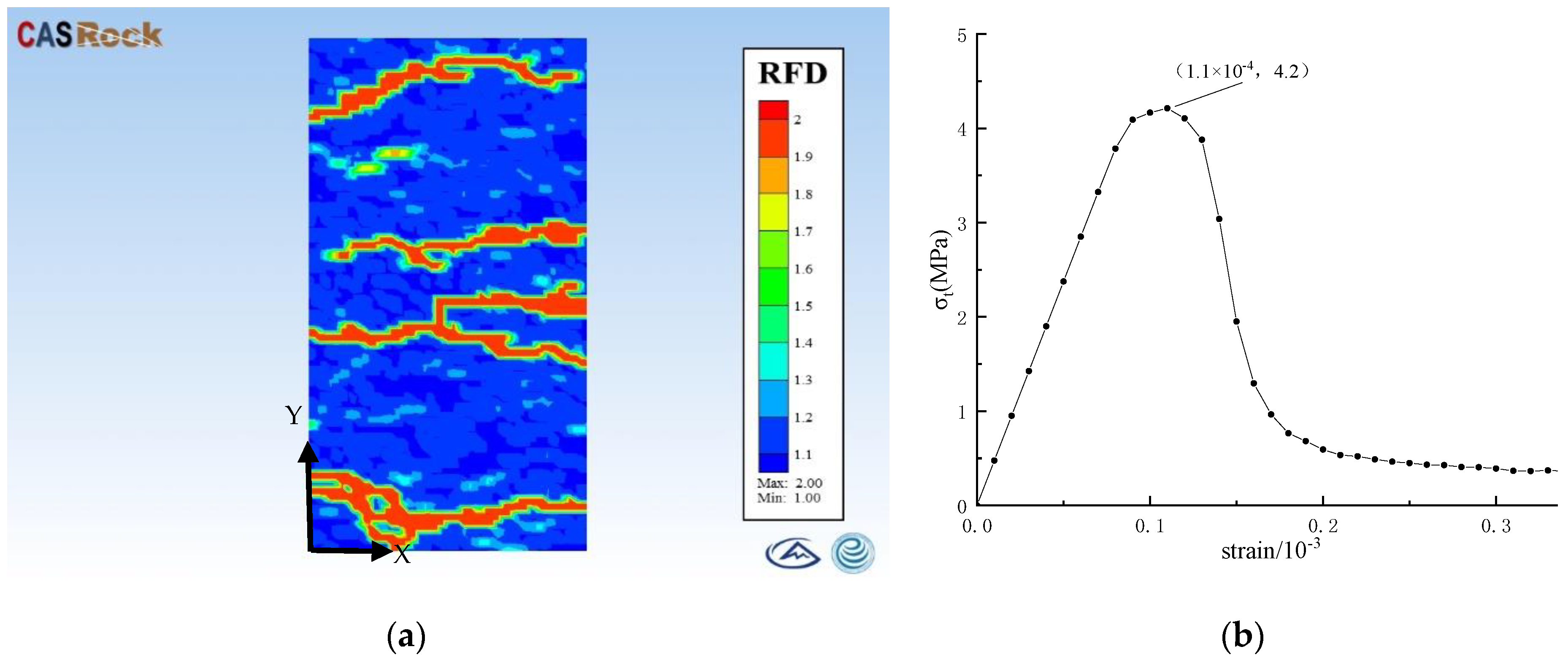
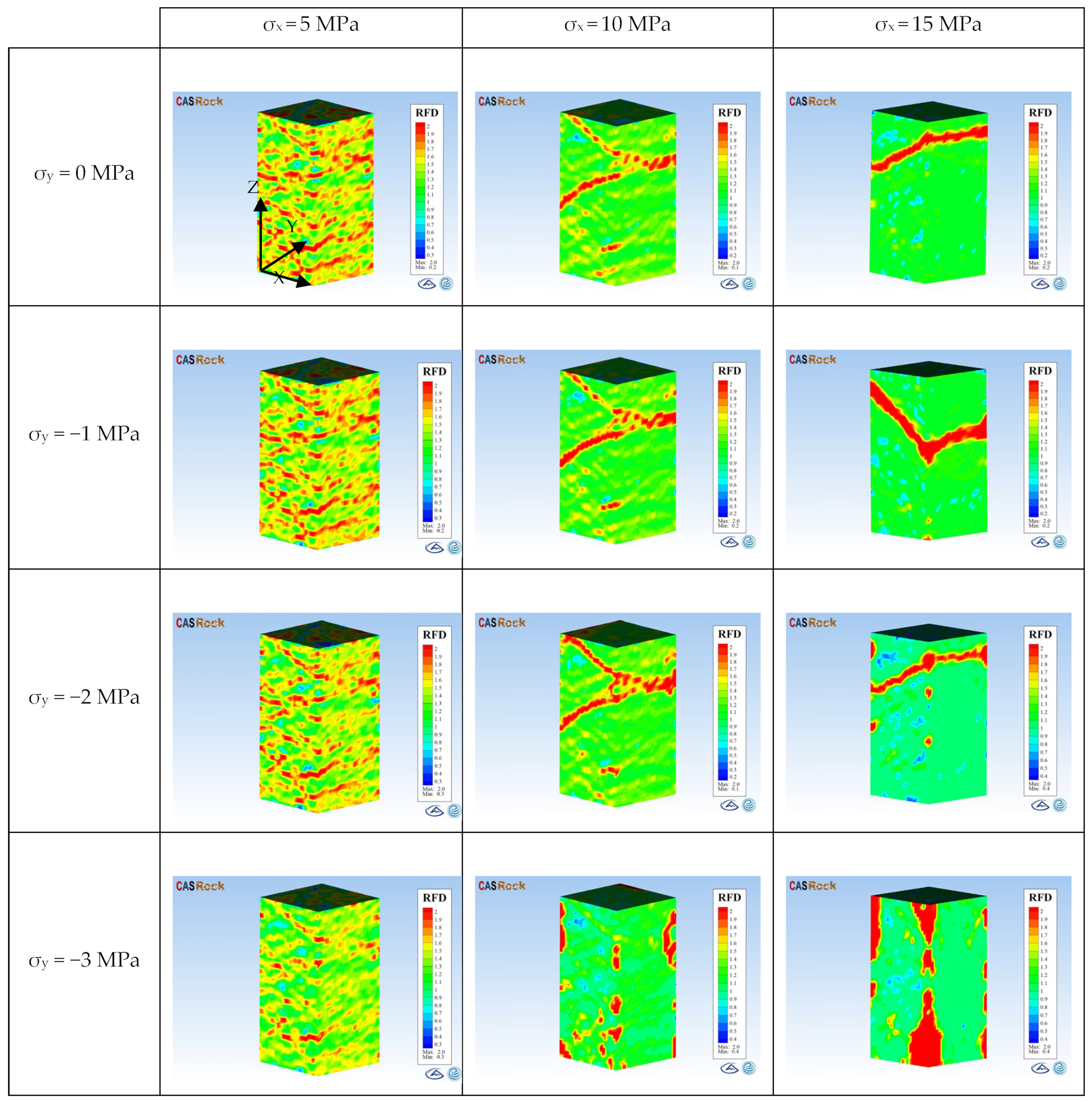


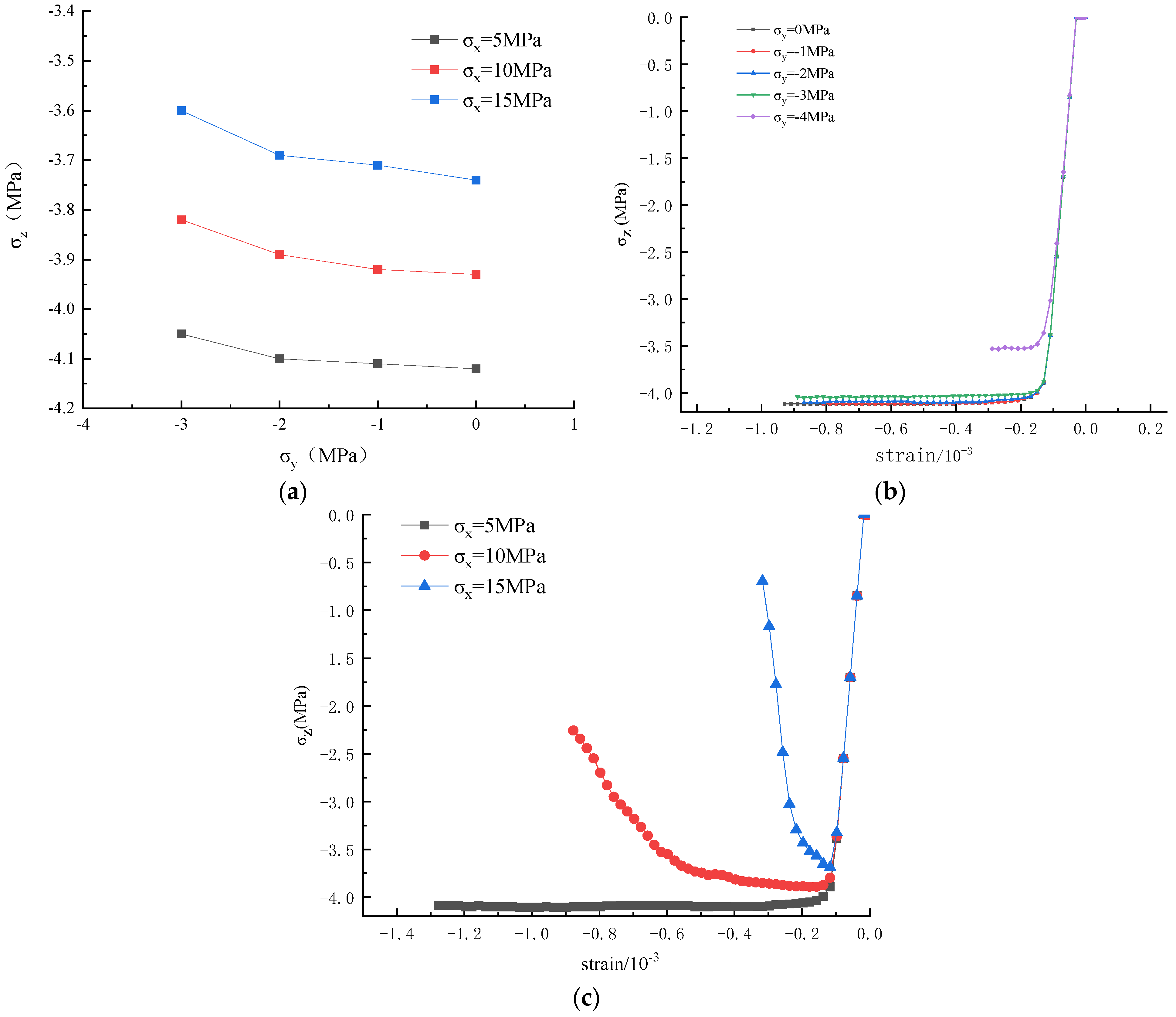
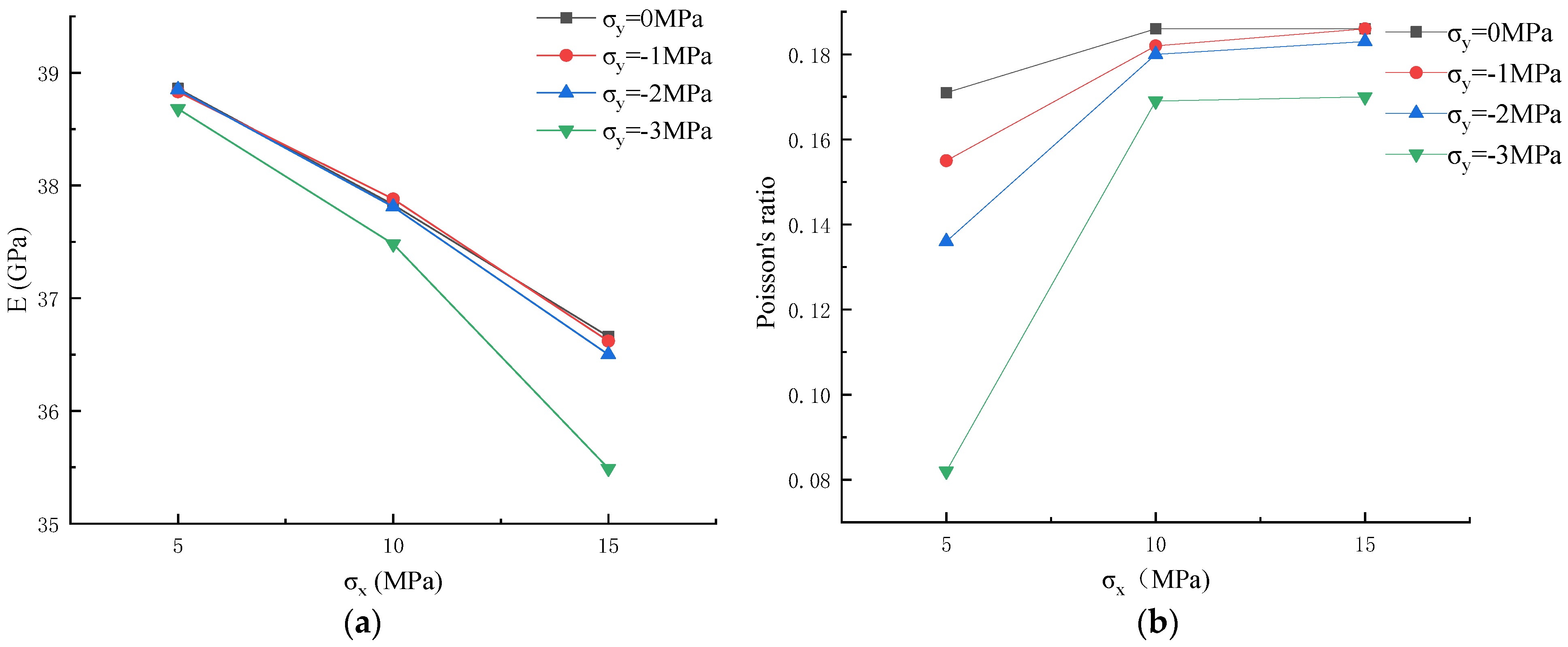
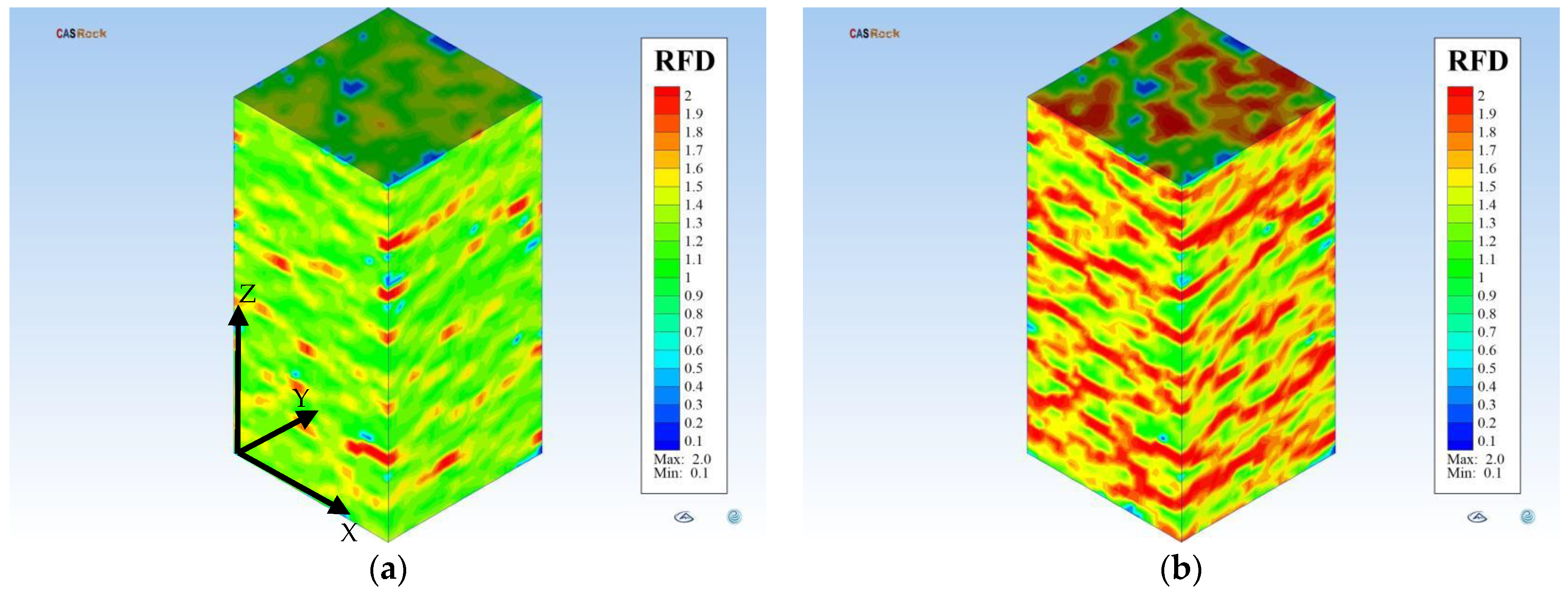
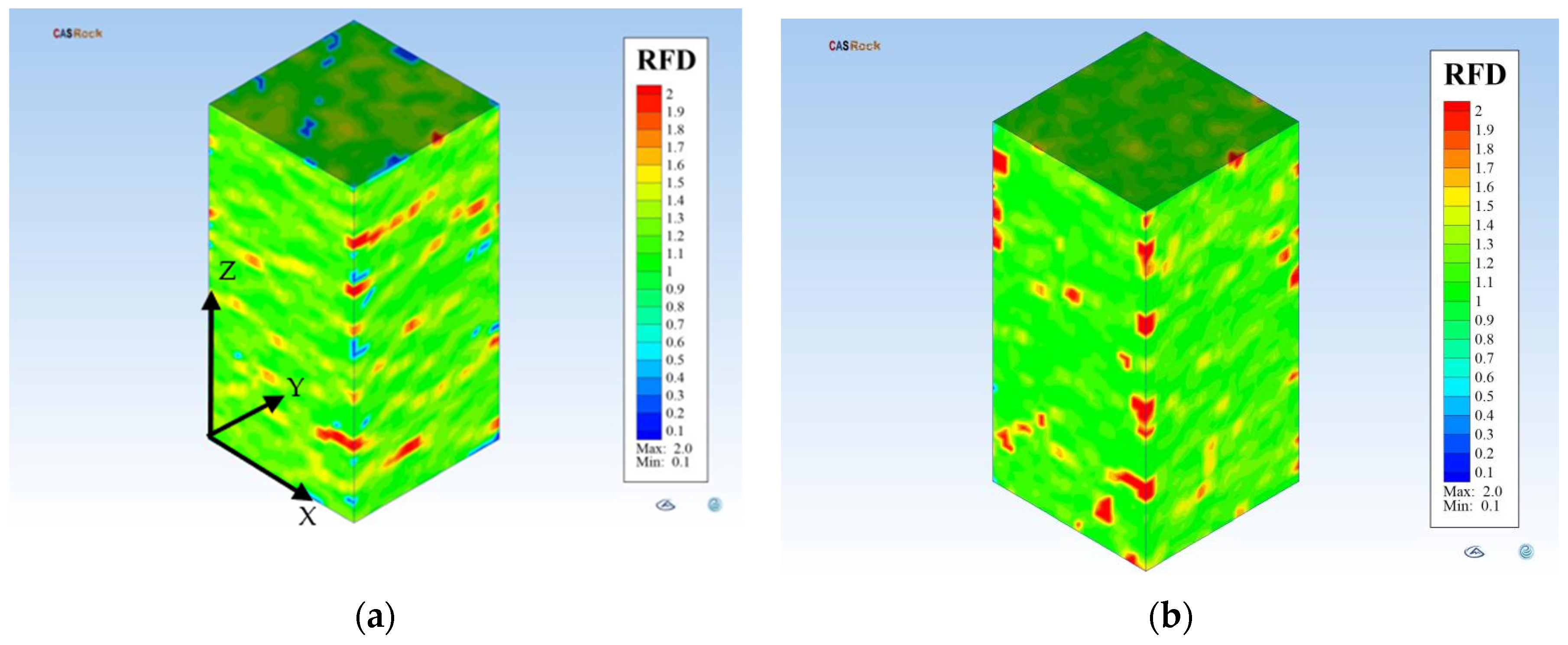
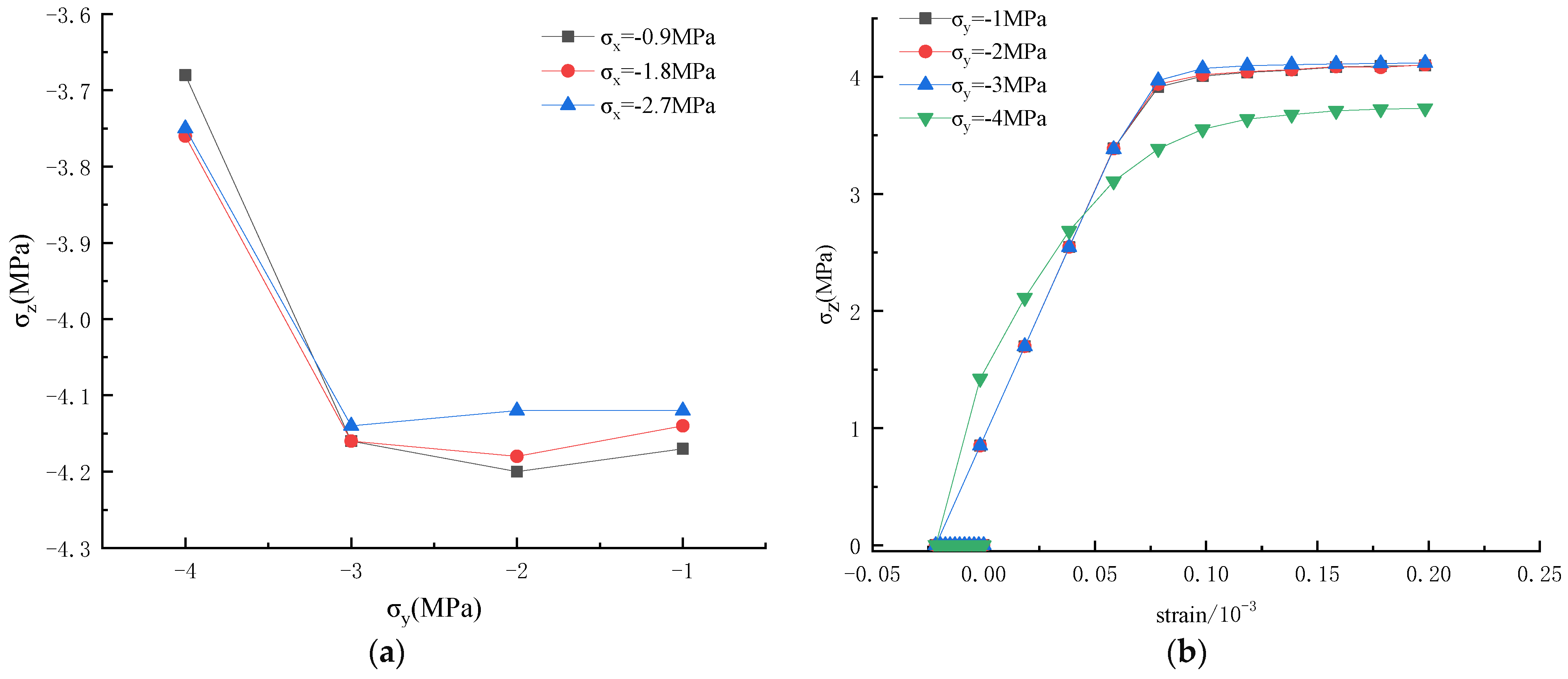
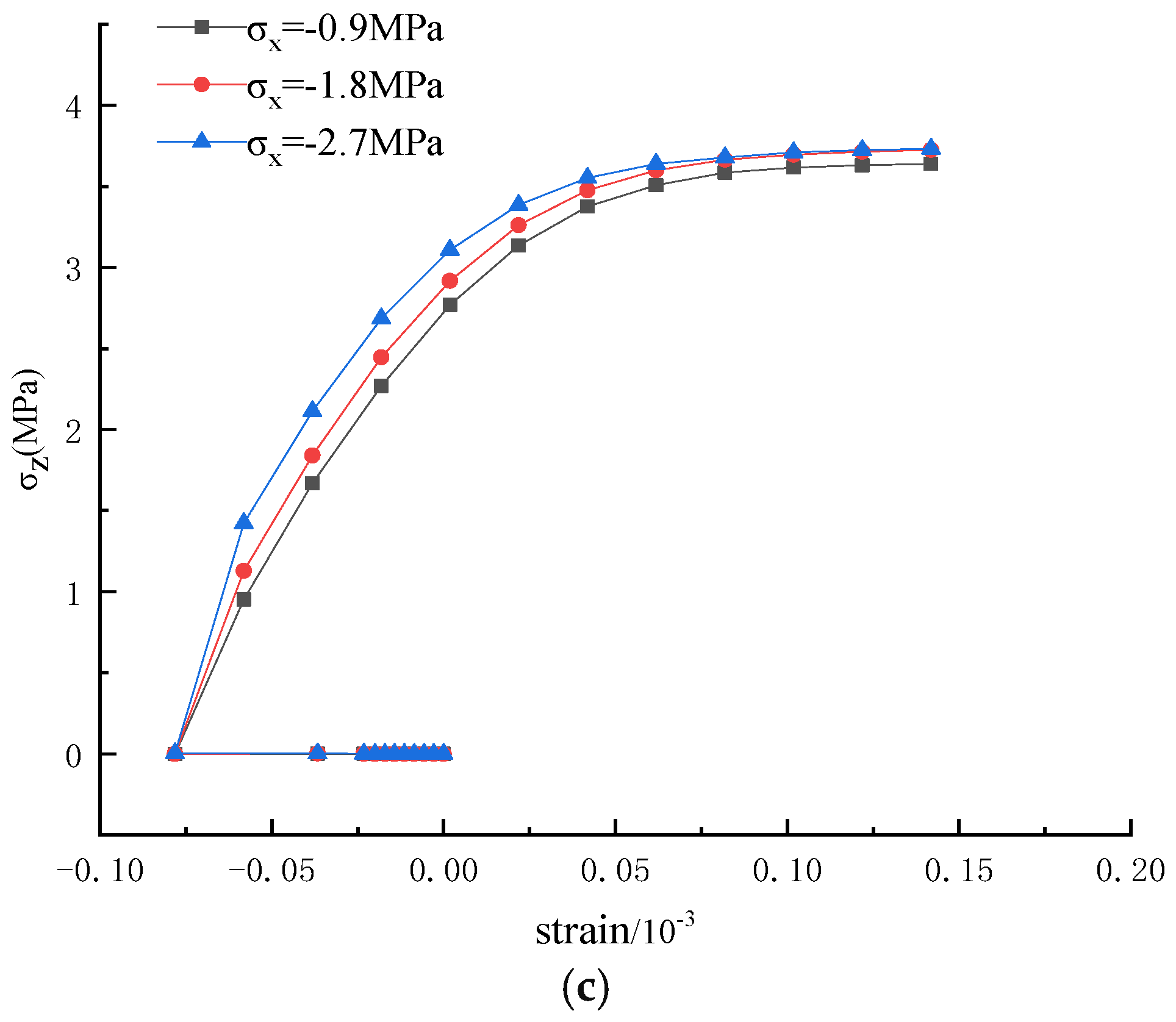
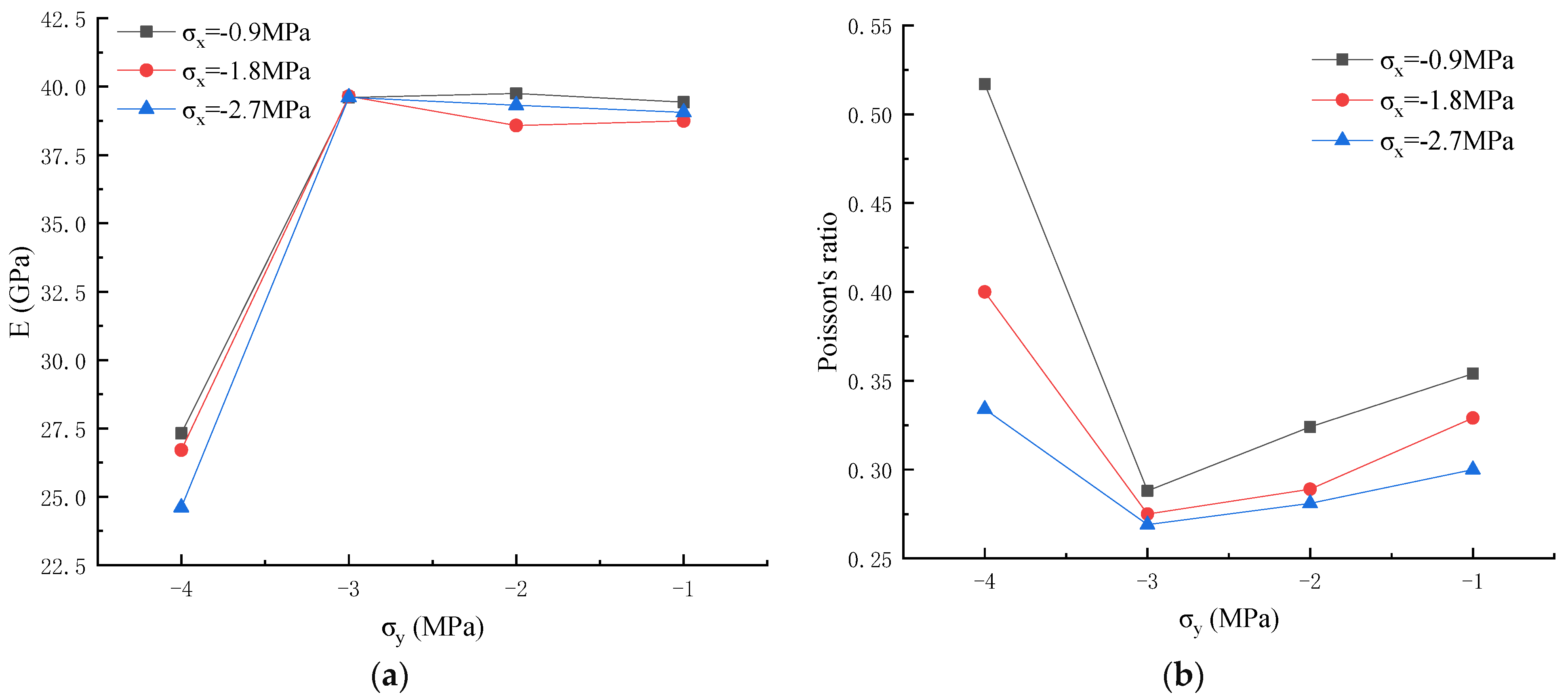
| Strength parameters | Cohesive force/MPa | 15 |
| Internal friction angle/° | 49 | |
| Shear dilatancy/° | 49 | |
| Tensile strength /MPa | 5.0 | |
| Deformation and physical parameters | Elastic modulus/GPa | 47.8 |
| Poisson ratio | 0.25 | |
| Density/kg/m3 | 2260 | |
| Heterogeneous coefficient | 4 |
| The Load-Direction | σx/MPa | σy/MPa |
|---|---|---|
| σy stretch, σx compression | 5, 10, 15 | 0 |
| −1 | ||
| −2 | ||
| −3 | ||
| σy, σx stretch | −0.9, −1.8, −2.7 | −1 |
| −2 | ||
| −3 | ||
| −4 |
| Order Number | σx/MPa | σy/MPa | σz/MPa |
|---|---|---|---|
| 1 | 5 | 0 | −4.12 |
| 2 | −1 | −4.11 | |
| 3 | −2 | −4.10 | |
| 4 | −3 | −4.05 | |
| 5 | 10 | 0 | −3.93 |
| 6 | −1 | −3.92 | |
| 7 | −2 | −3.89 | |
| 8 | −3 | −3.82 | |
| 9 | 15 | 0 | −3.74 |
| 10 | −1 | −3.71 | |
| 11 | −2 | −3.69 | |
| 12 | −3 | −3.60 |
| Order Number | σx/MPa | σy/MPa | σz/MPa |
|---|---|---|---|
| 1 | −0.9 | −1 | −4.17 |
| 2 | −2 | −4.20 | |
| 3 | −3 | −4.16 | |
| 4 | −4 | −3.68 | |
| 5 | −1.8 | −1 | −4.14 |
| 6 | −2 | −4.18 | |
| 7 | −3 | −4.16 | |
| 8 | −4 | −3.76 | |
| 9 | −2.7 | −1 | −4.12 |
| 10 | −2 | −4.12 | |
| 11 | −3 | −4.14 | |
| 12 | −4 | −3.75 |
Publisher’s Note: MDPI stays neutral with regard to jurisdictional claims in published maps and institutional affiliations. |
© 2022 by the authors. Licensee MDPI, Basel, Switzerland. This article is an open access article distributed under the terms and conditions of the Creative Commons Attribution (CC BY) license (https://creativecommons.org/licenses/by/4.0/).
Share and Cite
Zhou, L.; Ma, Z.; Xie, H.; Yang, W.; Zheng, H. Numerical Simulation Experimental Study of the Deformation and Failure of Granite with Multiaxial Tension. Processes 2022, 10, 949. https://doi.org/10.3390/pr10050949
Zhou L, Ma Z, Xie H, Yang W, Zheng H. Numerical Simulation Experimental Study of the Deformation and Failure of Granite with Multiaxial Tension. Processes. 2022; 10(5):949. https://doi.org/10.3390/pr10050949
Chicago/Turabian StyleZhou, Lang, Zhenqian Ma, Hongfei Xie, Wei Yang, and Hanghang Zheng. 2022. "Numerical Simulation Experimental Study of the Deformation and Failure of Granite with Multiaxial Tension" Processes 10, no. 5: 949. https://doi.org/10.3390/pr10050949
APA StyleZhou, L., Ma, Z., Xie, H., Yang, W., & Zheng, H. (2022). Numerical Simulation Experimental Study of the Deformation and Failure of Granite with Multiaxial Tension. Processes, 10(5), 949. https://doi.org/10.3390/pr10050949






